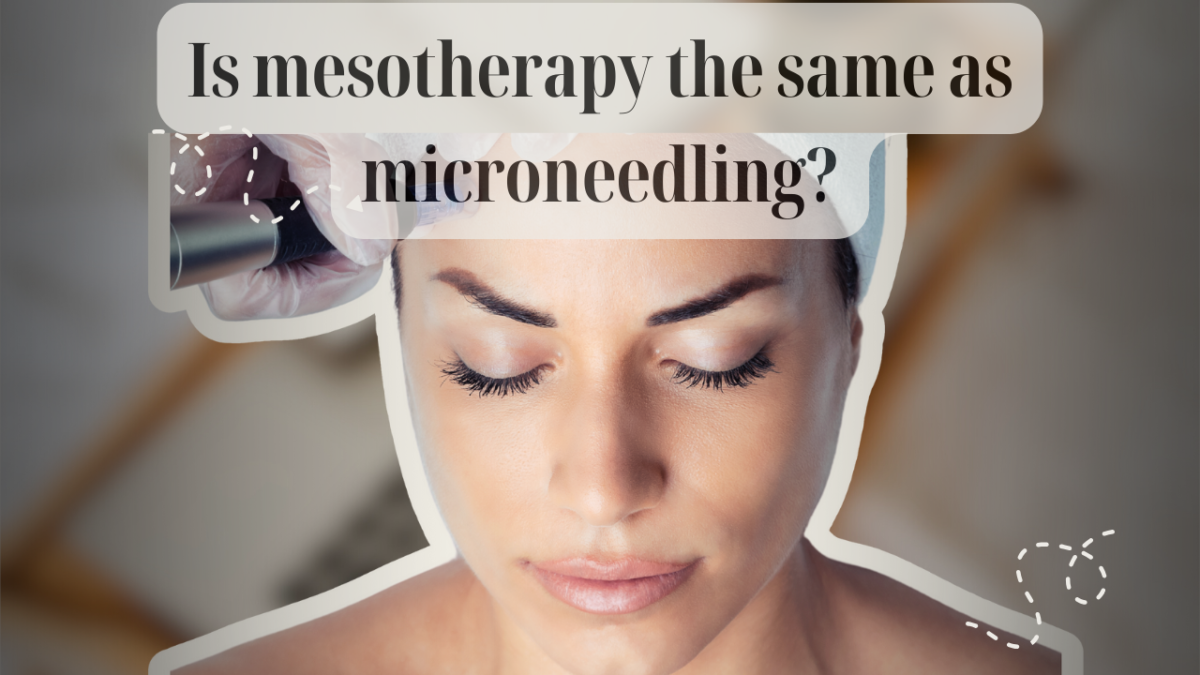Mesotherapy and microneedling are both advanced cosmetic treatments designed to enhance skin rejuvenation. While they share similarities in utilizing needling techniques, their methods and purposes vary significantly.
Understanding the distinctions between mesotherapy and microneedling is crucial for selecting the most effective treatment for your specific skin concerns. This article will provide:
- An overview of mesotherapy and microneedling.
- Insight into the benefits and applications of each treatment.
- A comparative analysis to help you make an informed decision.
By the end of this article, you will have a clearer understanding of which procedure may best suit your skin rejuvenation needs.
Understanding Mesotherapy
Mesotherapy is a technique that originated in France in the 1950s. It involves injecting a mixture of active ingredients directly into the skin. The term mesotherapy comes from meso, which means middle, as the treatment targets the mesoderm or middle layer of the skin.
Common Ingredients and Their Benefits
Mesotherapy uses a variety of ingredients tailored to specific skin concerns:
- Vitamins: Essential for skin health, vitamins like A, C, and E help to repair and protect skin cells.
- Hyaluronic Acid: Known for its hydrating properties, it aids in retaining moisture and plumps the skin.
- Growth Factors: Stimulate collagen production and cellular regeneration, contributing to overall skin rejuvenation.
Primary Purposes
The primary purposes of mesotherapy include:
- Collagen Rejuvenation: By stimulating collagen production, mesotherapy helps to improve skin texture and elasticity.
- Addressing Skin Laxity: The treatment tightens loose or sagging skin, providing a firmer appearance.
- Treating Dark Circles: Specific formulations can reduce pigmentation and improve circulation around the eyes.
By understanding mesotherapy’s definition, history, and the key ingredients used, one can better appreciate the treatment benefits it offers.
Exploring Microneedling
Microneedling is a non-invasive cosmetic procedure that has gained significant popularity since the 1990s. The technique involves using a device equipped with multiple ultrafine needles to create controlled micro-injuries in the skin, a process also known as dermal wounding. These micro-injuries stimulate the body’s natural healing response, leading to increased collagen and elastin production.
How Microneedling Works
- Device Mechanics: The microneedling device consists of a roller or pen-like tool with numerous tiny needles.
- Controlled Micro-Injuries: As the device moves across the skin, the needles puncture the dermis layer, creating micro-holes.
- Healing Response: These controlled injuries trigger the body’s wound-healing processes, which include collagen and elastin synthesis.
Benefits of Microneedling
Beyond its primary role in improving skin texture, microneedling offers multiple skin benefits:
- Fine Lines and Wrinkles: The enhanced collagen production helps to plump up the skin, reducing the appearance of fine lines and wrinkles.
- Scars Treatment: Effective for various types of scars, including surgical scars and pitted acne scarring.
- Improved Skin Texture: Regular treatments can result in smoother and more even-toned skin.
Microneedling stands out for its versatility and effectiveness in addressing different skin concerns through a minimally invasive approach.
Comparative Analysis: Mesotherapy vs. Microneedling
Techniques Comparison
Mesotherapy uses a technique where superfine needles are used to inject a mixture of vitamins, hyaluronic acid, and growth factors directly into the skin. This method targets specific issues by delivering active ingredients into the lower layers of the skin.
Microneedling, on the other hand, uses a device equipped with multiple ultrafine needles to create controlled micro-injuries in the dermis. These micro-injuries stimulate the skin’s natural healing process, encouraging collagen and elastin production.
Depth of Penetration
- Mesotherapy: Targets the lower layers of the skin, penetrating deeper to deposit nourishing ingredients directly where they are needed.
- Microneedling: Primarily affects the dermis, with adjustable needle depths allowing for precise treatments tailored to individual skin concerns.
Comfort Levels
- Mesotherapy: Generally considered more comfortable since it typically does not require topical anesthetics. The superfine needles used in mesotherapy cause minimal discomfort.
- Microneedling: Often requires topical anesthetics due to its invasive nature and the depth at which needles penetrate. Some level of discomfort is common during the procedure.
Understanding these key differences helps in choosing the right treatment based on individual needs and comfort levels.
Effectiveness for Specific Skin Concerns
Mesotherapy: Target Conditions
Mesotherapy is particularly effective for:
- Pigmentation Issues: The injection of vitamins and growth factors can lighten hyperpigmented areas.
- Dehydration: Hyaluronic acid infusions provide deep hydration, enhancing skin’s moisture levels.
- Collagen Rejuvenation: Promotes the production of collagen, addressing skin laxity and improving overall skin tone.
Microneedling: Best-Suited Skin Concerns
Microneedling excels in treating:
- Surgical Scars: The controlled micro-injuries stimulate collagen production, reducing the appearance of scars.
- Pitted Acne Scarring: By generating new skin cells, microneedling smooths out pitted scars.
- Fine Lines and Wrinkles: Enhances skin texture and firmness by boosting elastin and collagen.
Comparative Effectiveness
When comparing the two techniques in terms of anti-aging benefits:
- Fine Lines and Wrinkles: Microneedling is generally more effective due to its deeper penetration into the dermis.
- Overall Skin Health: Mesotherapy tends to provide better results owing to its targeted delivery of nutrients and hydrating agents.
Both treatments offer unique advantages for specific skin concerns, making them highly effective in their respective domains.
The Power of Combining Mesotherapy and Microneedling
Benefits and Considerations When Opting for Combination Therapy Treatment Sessions
Combining mesotherapy and microneedling in treatment sessions can result in enhanced results due to the synergistic effects of both techniques. This approach leverages the unique benefits of each method, providing comprehensive skin rejuvenation.
Advantages of Combination Treatments:
- Improved Efficacy: When used together, mesotherapy can deliver potent ingredients like vitamins and hyaluronic acid directly into the micro-channels created by microneedling. This ensures deeper penetration and maximizes the effectiveness of the serums.
- Faster Recovery Times: Microneedling-induced micro-injuries can enhance the absorption rate of mesotherapy solutions, speeding up recovery and promoting quicker skin renewal.
- Enhanced Collagen Production: Both treatments stimulate collagen and elastin production, but their combined use can amplify these effects, leading to firmer and more youthful-looking skin.
- Targeted Treatment: Mesotherapy addresses specific concerns such as pigmentation or dehydration, while microneedling improves overall skin texture. Together, they provide a holistic approach to skincare.
Considerations:
- Treatment Frequency: Sessions may need to be spaced out appropriately to allow the skin sufficient time to heal.
- Cost Implications: Combination therapy may involve higher costs due to the use of multiple treatment modalities.
- Skin Type Compatibility: Consulting with a dermatologist is essential to determine if this combination is suitable for your specific skin type and concerns.
Making an Informed Decision: Which Treatment Is Right For You?
When deciding between mesotherapy and microneedling, consider the following factors:
- Personal Goals: Identify whether your primary concern is skin rejuvenation or targeting specific issues like pigmentation and scars.
- Budget Constraints: Evaluate the cost of each procedure as mesotherapy might be more budget-friendly depending on the treatment area.
- Comfort Level: Mesotherapy is generally more comfortable compared to microneedling which may require topical anesthetics.
- Desired Results: If reducing fine lines and wrinkles is a priority, microneedling may offer more noticeable results. For overall skin health improvement, mesotherapy could be a better option.
Your final thoughts on mesotherapy vs microneedling should align with these considerations to make the best choice for your skin’s needs.

